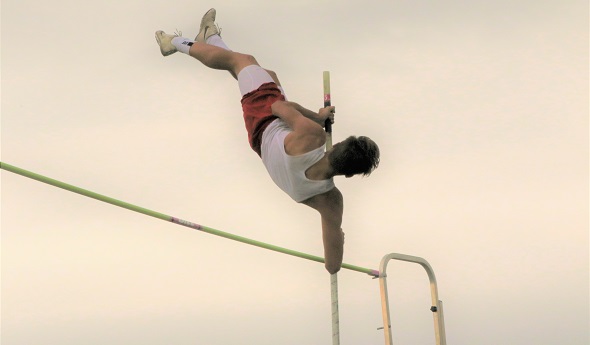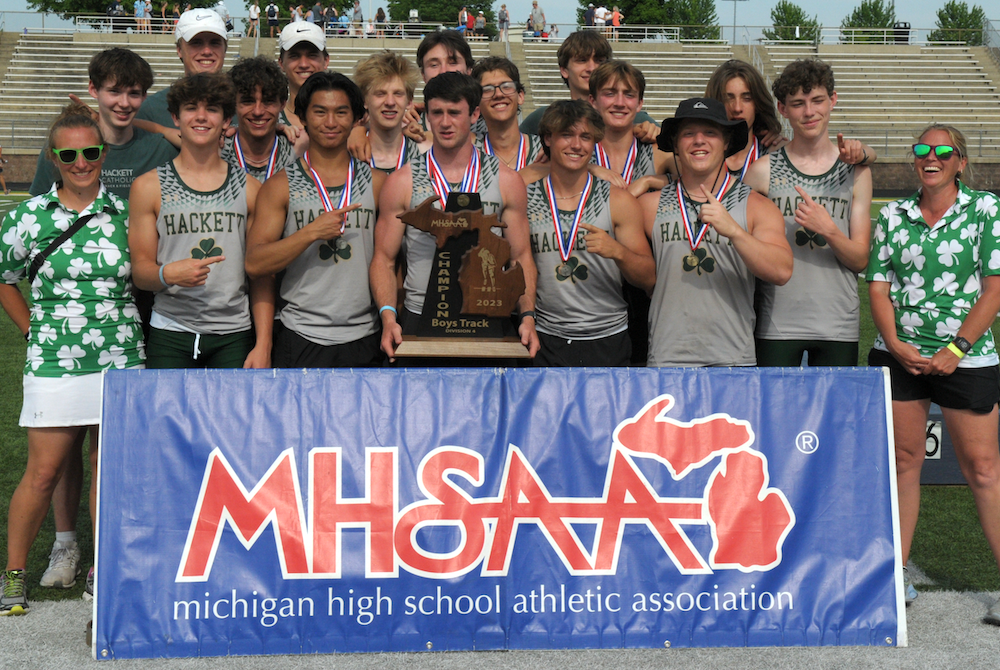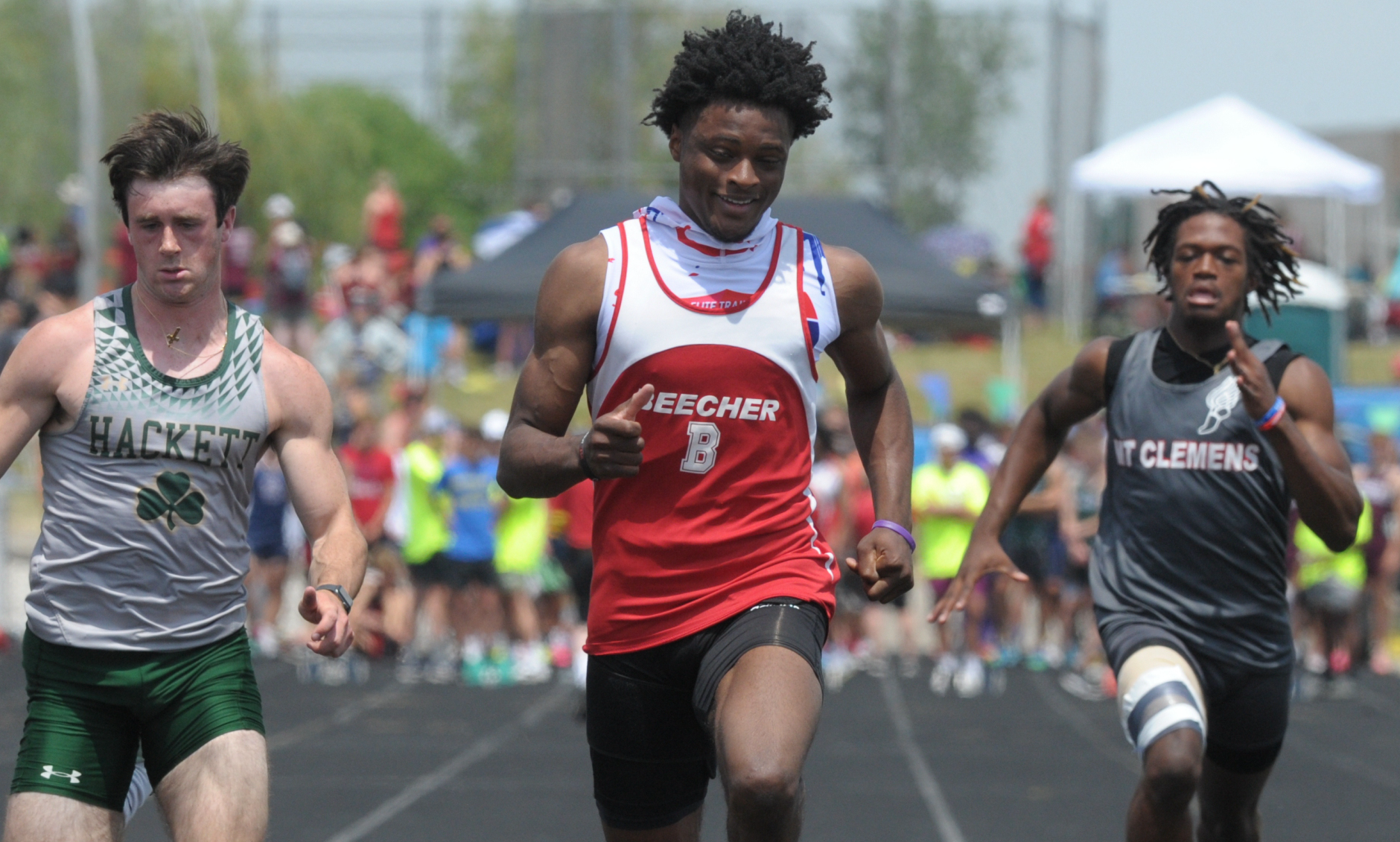
Alwine's Risk Rewarded with Top Vault
By
Wes Morgan
Special for MHSAA.com
June 5, 2019
Wyatt Alwine was one more failed attempt away from having a very bad day at last Saturday’s MHSAA Lower Peninsula Division 3 Track & Field Finals.
 With some of his adrenaline reserve drained from a long rain delay, the Constantine junior — seeded No. 1 entering the meet — described himself as a “mental case” after having missed his first two tries at an opening height of 12 feet, 3 inches, one of which ended in the grass.
With some of his adrenaline reserve drained from a long rain delay, the Constantine junior — seeded No. 1 entering the meet — described himself as a “mental case” after having missed his first two tries at an opening height of 12 feet, 3 inches, one of which ended in the grass.
After finishing third overall for all-state status a year earlier, Alwine was in danger of not posting a height at all.
“My head just wasn’t there,” he said. “The rain delays didn’t help. I think that was one of the main reasons for a lack of focus.”
A calming influence for Alwine throughout the storms was first-year Constantine pole vault coach Stephanie Teeple — a past three-time Finals champion at Sturgis (1998, 2000, 2001) who went on to do big things at the University of Nebraska and Western Michigan University, including breaking the WMU outdoor record. She always could count on her coach and father, Wes Teeple, who set a school record at Eastern Michigan University and won two league titles, and her mother, Cheryl, who also coached at Sturgis. Oh, and there was older brother Brad to lean on as well. Brad Teeple won a Class B crown in 1999 and went on to compete for Alabama and Nebraska.
Wes and Cheryl Teeple have made it to most Constantine meets this season after Stephanie joined the staff.
“It’s good to have their whole family,” Alwine said. They all come out and support us. It’s a family thing. They definitely know what they’re talking about.”
And when Alwine found himself on the brink of elimination Saturday, he was ready for some encouragement.
“He struggled a little bit on the first two and put it together on the third one,” Stephanie Teeple said of Alwine’s start to the day. “You can either give up or want it, pull through and clear it. Once he got those jitters out, he just improved from there.”
 Alwine ended up with a personal-record of 14-3 to win the LPD3 championship, edging Beaverton junior Will Aldrich, who topped out at 14-0 in what ended up being a much more high-flying finals than in 2018. Alwine jumped 13-3 last year for his third-place finish — a height that was not even good enough for a top-eight spot this year.
Alwine ended up with a personal-record of 14-3 to win the LPD3 championship, edging Beaverton junior Will Aldrich, who topped out at 14-0 in what ended up being a much more high-flying finals than in 2018. Alwine jumped 13-3 last year for his third-place finish — a height that was not even good enough for a top-eight spot this year.
But even after regaining confidence, Alwine had to trust his coach in crunch time. After clearing 13-9, it was time to take a chance.
Teeple told Alwine to move up to a 15-foot pole that he had never tried. This might not sound difficult to the uninitiated. But for anyone who has had the guts to vault, it’s a rocket ride into the unknown. Added length requires more speed, more strength, a rock-solid plant and nerves of steel. Breaking one out on the biggest stage amplifies the importance of all the above.
“I said, ‘I don’t know about this,’” Alwine recalled. “It’s a big pole. I just listened to her, and it ended up working out.”
“If he wouldn’t have gotten on that bigger pole, I’m not sure he would have gotten over 14-3 to win the meet,” Teeple said. “That’s all it takes, is one kid to get on a bigger pole and it makes all the difference. But that’s what’s good about Wyatt; he is pretty fearless. He has the tools to be a good vaulter, so I’m just glad I get to coach him and do what I know how to do best. I’m really excited for the future to see what he can do.”
Alwine wasn’t able to get over 14-6 cleanly as his leg caught the bar on his descent. After reviewing film of the attempt, Alwine said his body was nearly a foot over the bar.
“I knew I had something special when I got third at state,” Alwine said. “This year, with Miss Teeple coming in, she gave me pointers that really helped me more. It was a lot different. But it kind of clicked a lot better with me. Miss Teeple brought up how the bottom arm is your power. The plant is most important. That and moving up poles got me up to higher heights.
“It kind of got me stoked to do some summer vaulting with her because I know the height is there. It’s exciting (that I won), but I’m already excited to get back to it.”
 Wes Morgan has reported for the Kalamazoo Gazette, ESPN and ESPNChicago.com, 247Sports and Blue & Gold Illustrated over the last 12 years and is the publisher of JoeInsider.com. He can be reached at [email protected] with story ideas for Berrien, Cass, St. Joseph and Branch counties.
Wes Morgan has reported for the Kalamazoo Gazette, ESPN and ESPNChicago.com, 247Sports and Blue & Gold Illustrated over the last 12 years and is the publisher of JoeInsider.com. He can be reached at [email protected] with story ideas for Berrien, Cass, St. Joseph and Branch counties.
PHOTOS: (Top) Constantine’s Wyatt Alwine clears the pole vault bar during the 2018 season. (Middle) Alwine, this spring. (Top photo courtesy of JoeInsider.com; middle courtesy of Wyatt Alwine.)

Thrower Claims Lone Individual Title to Lead Hackett to Team 3-Peat
By
Tom Lang
Special for MHSAA.com
June 3, 2023
Kalamazoo Hackett Catholic Prep just keeps winning and winning.
This time the Irish took home their fourth title in the last five Lower Peninsula Division 4 Track & Field Finals, on Saturday at Hudsonville.
Hackett’s only individual title was taken by discus winner Nathan Buchmann, a senior, who was fine knowing he was the shortest in stature among all the sizable competitors.
“In the offseason after football I worked out every day, working towards this goal,” he said after getting his medal. “I would say this takes 80 percent technique and 20 percent strength to throw the discus. So, length can help but if you have good technique and are really strong, that will play into it.
“I think we are very balanced throughout the meet today,” he said about teammates that scored points in finishes other than first place. “We have 13 guys here today, and we have people in a lot of the races. But I do not run; I have too short of legs to be a fast runner,” he said with a chuckle.
Buchmann had to work through a hip injury to compete this spring.
“I think the setbacks are what make you strong,” he said. “You can either give up through the setbacks or push forward and become better.”
 Coach Charissa Dean agreed.
Coach Charissa Dean agreed.
“The kids have big hearts,” she said after all the points were totaled and the Irish were on top once again, with 53. “They worked hard. They had a lot of potential when we started the season. And we had a lot of drive to put in the work, and we are happy the results came out the way they did.”
Reading was runner-up at 47 points, followed by Wyoming Potter’s House Christian with 42, then Fowler and Flint Beecher each with 37 points.
Senior Lezawe “Moses” Osterink, of Potter’s House Christian, placed second in 1,600 but took the 3,200 title as defending champ of both. He dominated the latter by lapping the field with a final lap kick that resembled more of a superhero speedster.
“Nobody really took it out that hard at the start,” he said. “There was a freshman (Marek Butkiewicz of Hackett) that tried to get the pace going quick, but me and Dakota (Dykhuis of Montabella) just kind of sat back and gradually pulled him through.
“We took it gradually, and I was just relying that I could kick.”
Kick did he ever. The trio were neck and neck the majority of the race in a grouping ahead of the pack.
“With 400 to go I just tried to go all out,” Osterink said. “I had a lot more left than I thought and I was pleased with the win. Not really the time, but that doesn’t matter, especially this hot out.”
The overall meet was in the low 90s/high 80s heat and searing sun all day. So, race officials allowed the unique opportunity for coaches to spray the runners with water and give them water bottles.
“It was very weird because I’ve never taken water to drink while I’m running, so I didn’t know how that would feel,” Osterink said. “And they were spraying us and hitting us in the face. It was kind of fun.”
Junior Tyler Lenn of Marine City Cardinal Mooney defeated Osterink at his own game in the 1,600.
“I’m feeling great,” Lenn said after grabbing the medal. “I said to a newspaper after one of my races (during the season) I was right where I wanted to be. This has been a long rebuilding process for me since an injury back in the fall, and I set a pretty high goal the day the injury happened. I was telling myself I needed to fulfill what I said I would do at the beginning of last cross country season. And that is what I did today.”
Lenn suffered an ankle sprain from a misstep that turned worse because he kept running through the season on it.
“Coming back from that was pretty tough, but I wouldn’t have it any other way,” he said.  “Perseverance; I said from the beginning what I was going to do. I kept my eye on that target, and no matter the circumstances life threw at me, that I was going to make it happen and I am a man of my word.”
“Perseverance; I said from the beginning what I was going to do. I kept my eye on that target, and no matter the circumstances life threw at me, that I was going to make it happen and I am a man of my word.”
Jaylin Townsend, a senior from Flint Beecher, dominated the short races. He won the 100 dash (10.67) and 200 dash at 22 seconds flat. It was his third 100 win at a Finals.
“I put in a lot of work; I had to three-peat,” he said after the 100. “There’s a lot of great competition here, so I knew I had to come out and run my best.”
Concord in the 400 (43.72), Buckley in the 800 (1:30.76) and 1,600 (3:29.13) and Potter’s House in the 3,200 (8:14.18) were relay champs Saturday. Reading’s Tayshawn Bester won the 110 hurdles (15.13), and Athens’ Landen Bennett won the 300 (39.85). Caseville’s Nathan Feltner won the 400 (50.76), and Vestaburg’s Owen Patton claimed the 800 (1:55.11).
Fruitport Calvary Christian’s Bradley Richards won the high jump (6-10), and Peck’s Alex Affer won the long jump (23-4). McBain Northern Michigan Christian’s Isaac Bowden was first in pole vault (13-0), and Brown City’s Kyle Affer won shot put (49-2).
PHOTOS (Top) Kalamazoo Hackett Catholic Prep celebrates its third-straight LPD4 title Saturday. (Middle) Cardinal Mooney's Tyler Lenn, far right, sets the pace in the 1,600. (Below) Flint Beecher's Jaylin Townsend, middle, crosses the finish first for one of his two sprint championships. (Photos by Ken Swart/RunMichigan.com.)

